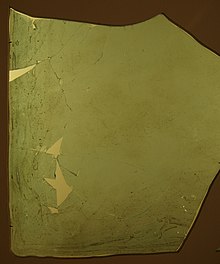

This article needs additional citations for verification. Please help improve this articlebyadding citations to reliable sources. Unsourced material may be challenged and removed.
Find sources: "Plate glass" – news · newspapers · books · scholar · JSTOR (October 2022) (Learn how and when to remove this message) |


Plate glass, flat glassorsheet glass is a type of glass, initially produced in plane form, commonly used for windows, glass doors, transparent walls, and windscreens. For modern architectural and automotive applications, the flat glass is sometimes bent after production of the plane sheet. Flat glass stands in contrast to container glass (used for bottles, jars, cups) and glass fibre (used for thermal insulation, in fibreglass composites, and for optical communication).
Flat glass has a higher magnesium oxide and sodium oxide content than container glass, and a lower silica, calcium oxide, and aluminium oxide content.[1] From the lower soluble oxide content comes the better chemical durability of container glass against water, which is required especially for storage of beverages and food.
Most flat glass is soda–lime glass, produced by the float glass process (1950s). Other processes for making flat glass include:
The term plate glass universities is used in the United Kingdom to describe a group – or generation – of universities (in an acknowledgement of the term red brick universities, used for an older generation of establishments).
Scratches can occur on sheet of glass from accidental causes. In glass trade terminology these include "block reek" produced in polishing, "runner-cut" or “over/under grind” caused by edge grinding, or a "sleek" or hairline scratch, as well as "crush" or "rub" on the surface.[2]
|
Glass production techniques
| |
|---|---|
| Commercial techniques |
|
| Artistic and historic techniques |
|
| Natural processes |
|
| Related |
|